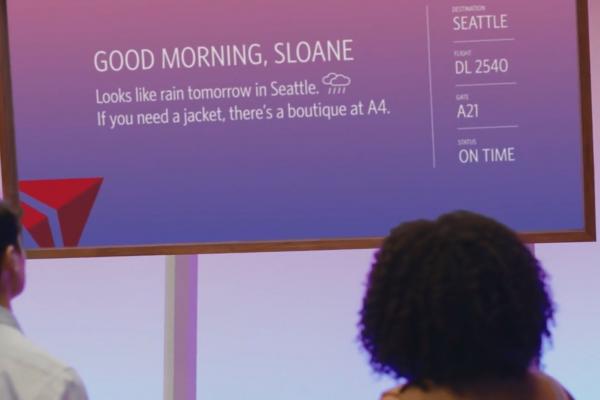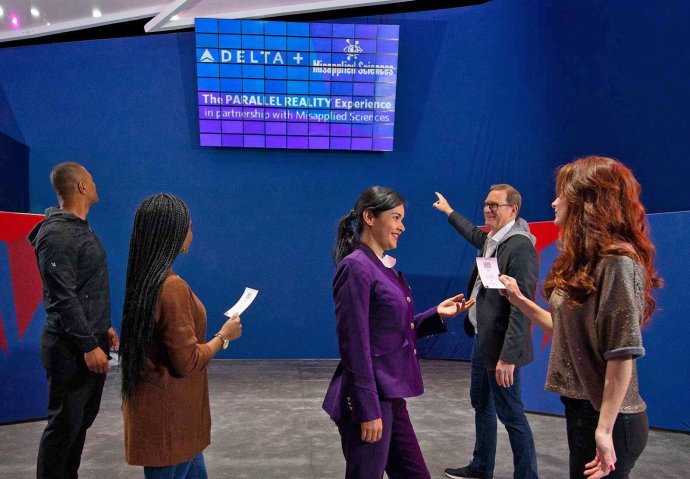
Start-Up Touts New Screen Tech That Shows 100 Messages, At Once
January 7, 2020 by Dave Haynes
I am usually a reasonably quick study on new technology, but a new display technology for airports touted at CES today by Delta Airlines and a Seattle-area start-up has me pretty much cross-eyed.
Delta has partnered with Misapplied Sciences (I like the name) to launch what is called a Parallel Reality display experience later this year at Detroit Metropolitan Airport. It’s a single screen that can show different personalized messages to different people – at the same time.
At a glance, says Delta in PR today, the category-defining technology will provide wayfinding and personalized travel information, like directions to your departure gate, or the closest Delta Sky Club.
“This breakthrough technology has to be seen to be believed – it has the potential to make even the busiest airports much easier to navigate, even if you don’t speak the language,” says Delta Chief Operating Officer Gil West. “Not only will Parallel Reality reduce stress and save time for our customers, but when combined with the warmth and thoughtfulness of our Delta people, the possibilities are endless.”
Totally concur on the seen to be believed thing, as I am struggling to “get” this. Not struggling so much that I wish I was in the hellscape of Vegas during CES week, but struggling.
For the beta experience in Detroit, the PR explains, nearly 100 customers will be able to simultaneously view personalized content tailored to their individual travel on a single large-scale digital screen located just after security. Customer and employee feedback from this opt-in trial will be critical to shaping the future experience.
Delta says it will work like this:
After moving through security at Detroit, travelers will see a Parallel Reality display near the Delta Sky Club (Concourse A, McNamara Terminal).
Delta customers departing from Detroit who want to participate can scan their boarding pass on the boarding pass scanner and select the language they want to use.
Leveraging multi-view pixels and proprietary technology, this innovation enables each customer to see personalized, in-language messages – tailored just to them – as they walk past the digital screen.
For the trial, tailored messages may include personalized wayfinding, flight information or updates, boarding time, the nearest Delta Sky Club or even upgrade/standby status.
This experience will always be opt-in, and customer information is not stored.
“We are looking forward to bringing this to life with Delta. The team there quickly saw the value the Parallel Reality experience would bring to its customers and had the vision, brand and resources to help bring it to market,” says Albert Ng, Misapplied Sciences CEO. “While we will start with Delta customers in Detroit, eventually Parallel Reality technology can be used to create seamless, engaging and personalized experiences in nearly any out-of-home venue – ranging from stadiums to theme parks to convention centers and more.”

I went on the Misapplied website to try to learn more. It SEEMS like the display is a custom unit that looks like a low rez LED from 10-20 years ago. What’s shown on the promo video by Delta is very different from what’s in the CES booth.
There are big bezels between the modules, and visual presentation ain’t great. But this, very presumably, a latter stage proof of concept, and would not reflect the company’s ideas on a finished product.
The short explanation is that normal LED light pixels can do one color at a given moment, whereas this start-up’s light pixels can do millions, and at variable brightnesses. The challenge is those light chips are kinda big, as tends to happen with start-ups who don’t have manufacturing facilities and many-million-dollar R&D budgets.
The company explains it this way:
HIGH PERFORMANCE PARALLEL COMPUTATION: Harnesses a network of proprietary pixel processors to efficiently coordinate a massive number of light rays in real-time.
Plus – SIMPLIFIED PROGRAMMING INTERFACES: Translate complex underlying calculations into manageable software applications.
Plus – REAL-TIME ENVIRONMENTAL MODELING TOOLS: Enable everyday users to easily direct visual media to specific people and places.
Plus – EXPERIENTIAL DESIGN: Converges additional technologies such as sensors, UI devices, tracking, machine vision, data management, and predictive analytics to create a world of applications.
Adds up to – PARALLEL REALITY Displays
It is, of course, interesting, and it would be hugely helpful to personally see at some point, but Redmond, WA is a bit of a drive from my place. ISE or Infocomm, maybe???
If it really does work, and if the LED pixels (or whatever this is) are reduced to a size that makes for a good-looking, reasonably fine pixel pitch display, then the messaging and advertising applications could be enormous.
And if it works, someone like neighbor Microsoft, or more likely an LED giant like Leyard, would probably buy them and the IP.
The guy behind it has electrical engineering degrees from Caltech and Stanford, so he’s no dummy. And Delta, even if it was just looking for whiz-bang stuff to have a presence at CES, would not be aligning itself with this unless there was really something there.
Certainly tech to watch …
BTW – This is being shown at Delta’s CES booth – #14035 in Central Hall – so any poor signage soul at CES can stop by and send me their thoughts/explanations/pix.
Here’s the take from The Verge …



Leave a comment